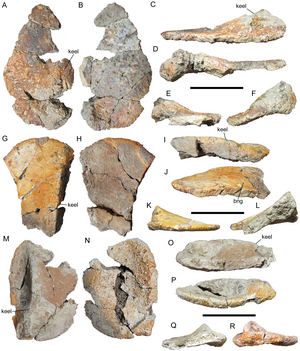Invictarx
| Invictarx | ||||||||||||
|---|---|---|---|---|---|---|---|---|---|---|---|---|

Holotype of Invictarx Zephyri : isolated osteoderms the neck and shoulder areas |
||||||||||||
| Temporal occurrence | ||||||||||||
| Lower Campanium ( Upper Cretaceous ) | ||||||||||||
| 83.6 to 80.6 million years | ||||||||||||
| Locations | ||||||||||||
|
||||||||||||
| Systematics | ||||||||||||
|
||||||||||||
| Scientific name | ||||||||||||
| Invictarx | ||||||||||||
| McDonald & Wolfe , 2018 | ||||||||||||
Invictarx is a Ankylosaurier - genus of the family nodosauridae . It is found fossil in the lower Campanian (83.6 to 80.6 mya ) of the US state New Mexico . The only known species is Invictarx zephyri .
etymology
The generic name Invictarx is derived from the Latin words invictus ('invincible, impregnable') and arx ('fortress') and refers to the animal's osteodermic armor. The species epithet of the type species is the genitive of the Latin word Zephyrus ('west wind') and was chosen on the basis of the strong winds that prevail in the region in which the fossil material was recovered.
features

Invictarx is known only from relatively few, often fragmentary, postcranial individual bones and skin ossification, so-called osteoderms and ossicles, which originate from three different individuals (each discovered and collected in May 2011, October 2011 and October 2015). Accordingly, little can be said directly about general characteristics of the genus. Based on the size of the finds, the length of the Invictarx must be approx. 3 to 4 meters.
A mix of special features that is unique in this form is indicated as diagnostic , which are also known individually from other nodosaurids. The osteoderms are all relatively smooth, without heavy sculpting, have numerous, randomly distributed dimples on the outside and have no or a small number of bifurcated (Y-shaped) and non-bifurcated neurovascular grooves (i.e. impressions of nerve tracts and / or blood vessels), similar to Glyptodontopelta mimus , but without the dense pattern of multiply branched (dendritic) grooves typical of this species. Some osteoderms have a low, rounded keel with a longitudinal (cranio-caudal) groove along the apex line ("split keel"), as occurs in Anodontosaurus lambei and Platypelta coombsi , but not in Glyptodontopelta mimus . In addition, Invictarx probably had a pelvic shield made of approximately the same size, polygonal , fused osteoderms, as found in several other nodosaurs, etc. a. Nodosaurus textilis , Stegopelta landerensis , Glyptodontopelta mimus and Europelta carbonensis as well as the ankylosaurid Aletopelta coombsi . The osteoderms are particularly similar to the so-called morphotype C (the "category 3 pelvic shield") of G. mimus .
distribution
All fossil material of the genus was recovered from the Juans Lake Strata in the upper part of the Allison subformation of the Menefee Formation of San Juan County in the northeast of the US state New Mexico . The Juans Lake strata are dated to the Lower Campan (higher Upper Cretaceous ). The tyrannosaurid dynamo terror , which has also been handed down in fragments, was described from the same shift interval, possibly even from the same locality .
Paleogeographically, San Juan County lies in the western part of North America called Laramidia , which was separated from the East called Appalachia in the Upper Cretaceous by the Western Interior Seaway.The presence of a nodosaurid in the Menefee Formation confirms the hypothesis that nodosaurids were present in Laramidia throughout the Upper Cretaceous, while the ankylosaurids died out there in the Cenoman and did not immigrate again from Asia until the Campan at the earliest.
Systematics
Due to the fragmentary nature of the fossil record and the limited amount of anatomical information available, the exact phylogenetic location of Invictarx could not be determined using cladistic analysis. The fact that the genus belongs to the nodosaurids is indicated by the relatively high thickness of the osteoderms and the flat to slightly concave shape of the base surface of the osteoderms as well as the approximately circular proximal articular surface (i.e. pointing towards the "elbow joint") of a right radius (corresponds to the spoke in the human forearm). The greatest similarities of the fossil material from Invictarx exist with the genus Glyptodontopelta , also from San Juan County, but from the Ojo-Alamo formation (originally as ankylosaurids) , whereby the status of the nodosaurids from the Menefee formation as an independent genus with his around 10 million years older is established (see → characteristics ).
Web links
literature
- Andrew T. McDonald, Douglas G. Wolfe: A new nodosaurid ankylosaur (Dinosauria: Thyreophora) from the Upper Cretaceous Menefee Formation of New Mexico. PeerJ. Vol. 6, 2018, item no. e5435, doi: 10.7717 / peerj.5435 .
Individual evidence
- Jump up ↑ Andrew T. McDonald, Douglas G. Wolfe, Alton C. Dooley Jr: A new tyrannosaurid (Dinosauria: Theropoda) from the Upper Cretaceous Menefee Formation of New Mexico. PeerJ. Vol. 6, 2018, item no. e5749, doi: 10.7717 / peerj.5749 .
- ↑ Victoria M. Arbor, Lindsay E. Zanno, Terry Gates: Ankylosaurian dinosaur palaeoenvironmental associations were influenced by extirpation, sea-level fluctuation, and geodispersal. Palaeogeography, Palaeoclimatology, Palaeoecology. Vol. 449, 2016, pp. 289–299, doi: 10.1016 / j.palaeo.2016.02.033
- ↑ Traci L. Ford: A review of ankylosaur osteoderms from New Mexico and a preliminary review of ankylosaur armor. Pp. 157-167 in Spencer G. Lucas, Andrew B. Heckert (Eds.): Dinosaurs of New Mexico. New Mexico Museum of Natural History and Science Bulletin 17, 2000 ( online ), p. 171

